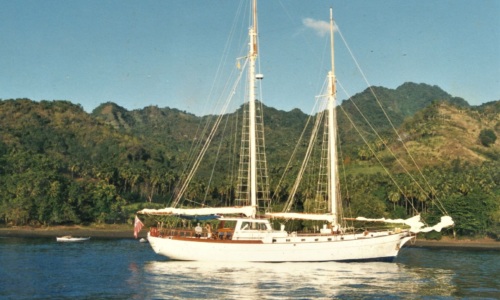Laurent Saint-Cyr: confirmation of his vocation as a sailor (part 2: adulthood)
After his first delivery between Martinique and Toulon, Laurent finally finds a motorcycling courier job for three months. Then, with a friend, Lionel, he embarks on entrepreneurship by launching the Grand Large[1]Grand Large in French means open sea Company (a reference to the lake of his childhood?) which specializes in – guess what? – boats, and more particularly rental / sale during fine weather and wintering in the off-season. But like french write Marcel Pagnol’s Marius, our Ulysses cannot resist the call of the ocean and, at the same time as managing his company, sets out again at sea: in summer, as skipper for cruises, in particular to Corsica, and in winter as an instructor for Parisians keen on sailing.
At the age of 30, with his friend, he sells the business and begins to get seriously bored. He positions himself again in the building sector. During the winter, when the weather is not favorable for the worksites, he makes convoys across the Atlantic and the Mediterranean, in a whirlwind of marine adventures. Whirlwind in the true sense of the word, by the way. In 1990, Laurent sets sail aboard a Lagoon 42, in Boston, and head for Martinique, accompanied by his girlfriend and his father (for whom this is the first delivery).
It’s Christmas and the water in the American port is freezing in places. The boat is a comfortable 42 ft (12.80m) catamaran. It’s a multihull so it doesn’t have a keel: its lightness allows it to go down breaking waves. And breaking waves, Laurent will have some! Having left with two other skippers who run two ships of the same type, he will have to face what he calls “gales” for two weeks. For fifteen long days, he will play with the raging ocean, use the bewildering force of the waves [2]As a reminder, waves are not moving masses of water: they are created by a sea wave that spreads to the shore. In the North Atlantic, during storms, waves can easily reach heights of ten meters, while the highest ones go up to over thirty meters.. This means, for a multihull, that an experienced captain will be able to use the wave as a kind of slide on which the boat will glide at full speed. But beware! In the event that the top of the breaking wave catches up with the boat and falls on it, the wave will overturn the sailboat like a vulgar piece of straw. Let us not forget either the main characteristic of multihulls: if they offer unequaled comfort on warm coastal waters, such as the Caribbean, and because of their shallow draft [3]Minimum height to float below which a boat touches the seabed. they offer the possibility to contemplate some paradisiacal shores up close, the absence of a keel means that their absolute balance is the mast below and the floats above.
Thus, in this crazy outfit started in Boston at the beginning of winter 1990, on the three boats, the second arrived in bulk [4]According to Laurent’s own expression. in Bermuda. The third has disappeared, body and soul. This shipwreck, as well as the one narrowly avoided one in the Caribbean, will get the better of the Horizons Pluriels company which (among other things) managed these catamarans.
Fortunately for him, after these two weeks of challenging and dangerous ferrying, Laurent and his crew abruptly leave the cold Labrador Current and found themselves, within twenty-four hours, in the waters of the Gulf Stream, in a sub-tropical climate[5]On the East coast of the North American continent, one passes quickly from a sub-polar climate to a hot sub-tropical one. Off New York, in winter, one can meet icebergs while less than 700 km further south, at the latitude of Jacksonville (North Carolina), the month of January displays an average temperature of 7.2 ° c (compared to 4.7 ° c in Paris). On the other hand, on the West coast of the United States, Canada and Alaska, the sea current Kouro Chivo (North Pacific) brings a mild climate even up to the far north. For example, the town of Sitka (southwest coast of Alaska) enjoys a temperature average of 0.5 ° c in January while that of Nain (Labrador, Canada), a town located at the same latitude but on the other side of the continent, displays -14.8 ° C also in January. The same phenomenon is happening with the Eurasian continent..
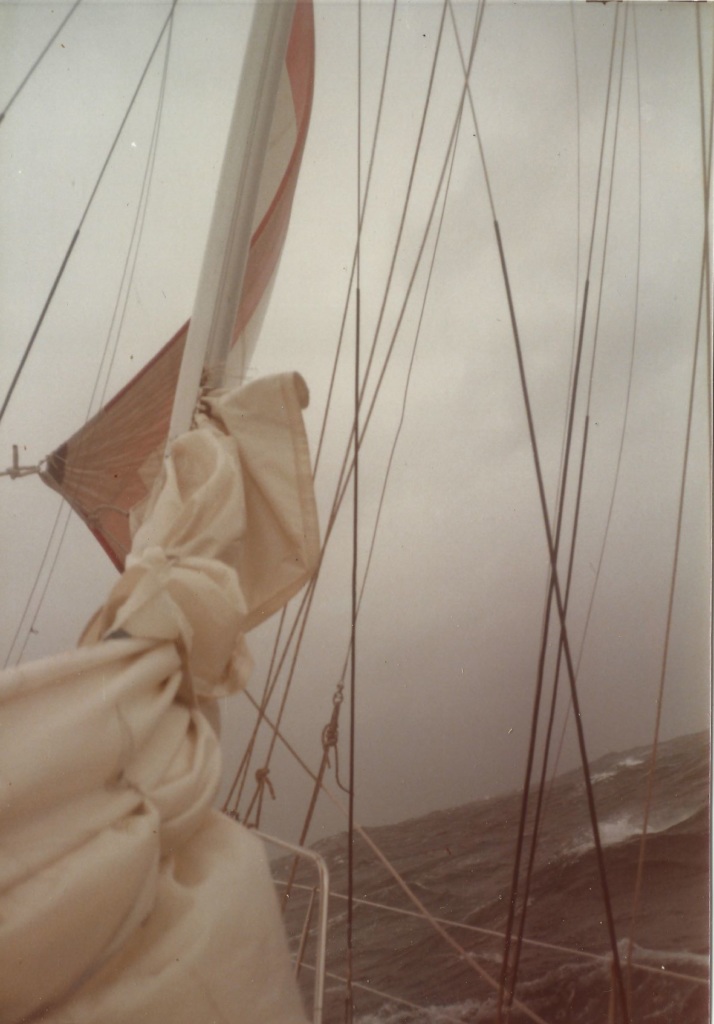
After this episode which will confirm both his vocation and his reputation as a sailor, Laurent will continue the convoys. Different highlights await him: during one of them, near Cape Finisterre, in the Bay of Biscay known for its capricious weather and sea, particularly in winter, a breaking wave lays the boat, an Oceanis 500 (50 feet, i.e. 15.24 m, and weighing more than 15 tons). The two helmsmen are carried away by the wave! Fortunately, as an experienced and careful captain, our Ulysses had asked them to attach their harness to the lifeline[6]The lifeline is a secure cable that runs along both sides of each boat. When the weather gets tough, it is very strongly recommended to attach the carabiner of the life jacket harness to this cable.. However, as it is a keelboat, the ballast does its work and the boat regains its absolute balance: the keel down and the mast up (the opposite of multihulls)!
Another time, Laurent is on his way to Turkey. We are in November. Force 9 on the Beaufort scale. The sea is white with foam and it smokes. Ulysses decides to heave to, that is to say to tuck in the tormentine [7]The tormentine is a very small headsail, in thick fabrics, which is used during storms. while putting on the helm in opposition in order to immobilize and stabilize the boat. It’s a bit like the sailors’ way of keeping their backs when there is not much else to do.
Another astonishing moment: our navigator is between Sicily and the Balearic Islands. As in the French song[8]Il était un petit navire / There Was A Little Ship, food becomes scarce, especially Camembert cheese, wine and tobacco. Never mind, Laurent crosses, in the middle of the Mediterranean, the path of his friend Lionel with whom he had created, a good ten years earlier, Grand Large, their boat management company. Far from all coasts, the sailboats come side by side, and the two captains exchange a lot of hugs, laughter and food!
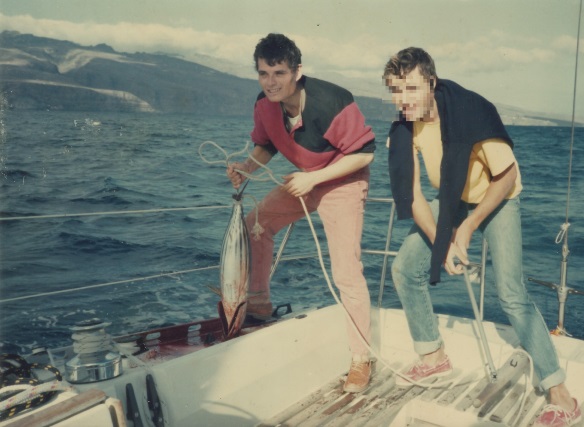
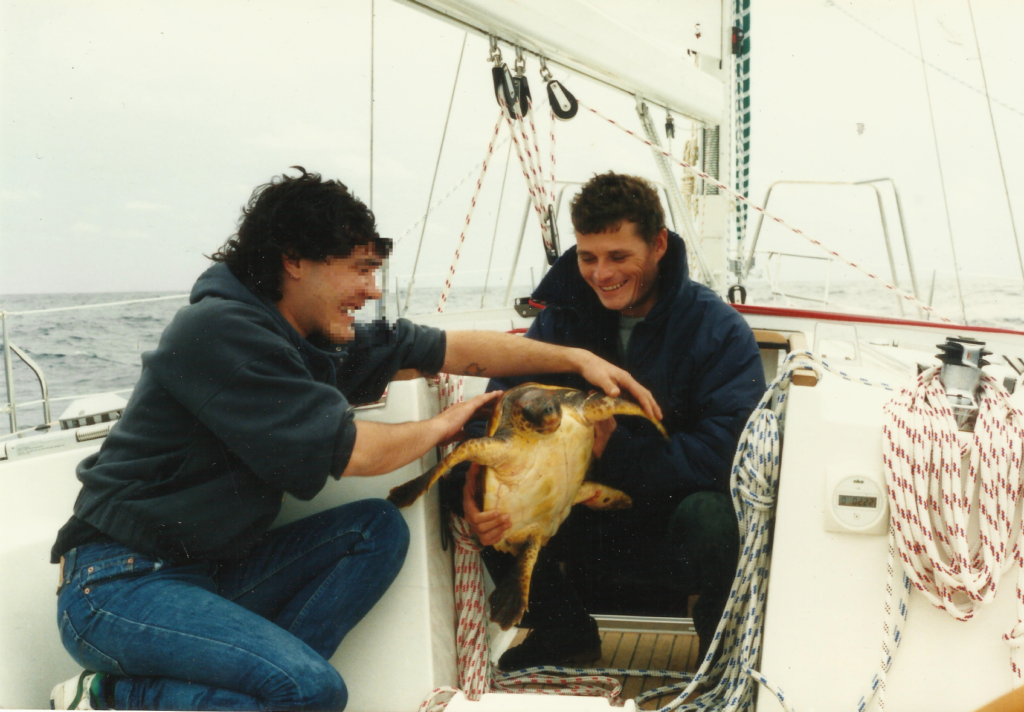
Another episode caught Laurent’s attention. We are in December. After ahving left Sainte Maxime, he heads for Majorca where he intends to stop. Except that between the two, the wind picks up at Force 8 and the Grande Bleue (The Great Blue as is called the Mediterranean Sea) transforms into unleashed fury, digging her waves as only she can. A wave bigger than the others carries Laurent like a rag doll, despite the fact that he was firmly installed in the cockpit. Back on board, he takes again the helm amidst the raging elements. After 42 of driving the boat, a wave, more sly than the others and taking advantage of the captain’s fatigue, sweeps over the sailboat and the sea carries the skipper again! His harness, attached to the lifeline, will therefore have saved his life twice in a single trip.
However, around the age of forty, our Ulysses, after a month of vacation, makes a decision: he won’t any more accompany tourists! From now on, he will sail on the same boat and take the latter wherever his sailing owner asks him to. He finds a skipper position on an auric schooner 21.50 m long (all out) and 50 tonnes: the Blue Lion.
For several years, Laurent will sail aboard this magnificent vessel, happy as a Pope, paid to do what others are ready to pay fortunes for! Completely in his element, he will continue to sail on the waters which are known to it from now on: the crossing of the Atlantic towards the Caribbean using the trade winds and the north-equatorial current and then back again, thanks to the Gulf Stream (wind and current); without forgetting the trans-Mediterranean convoys too.
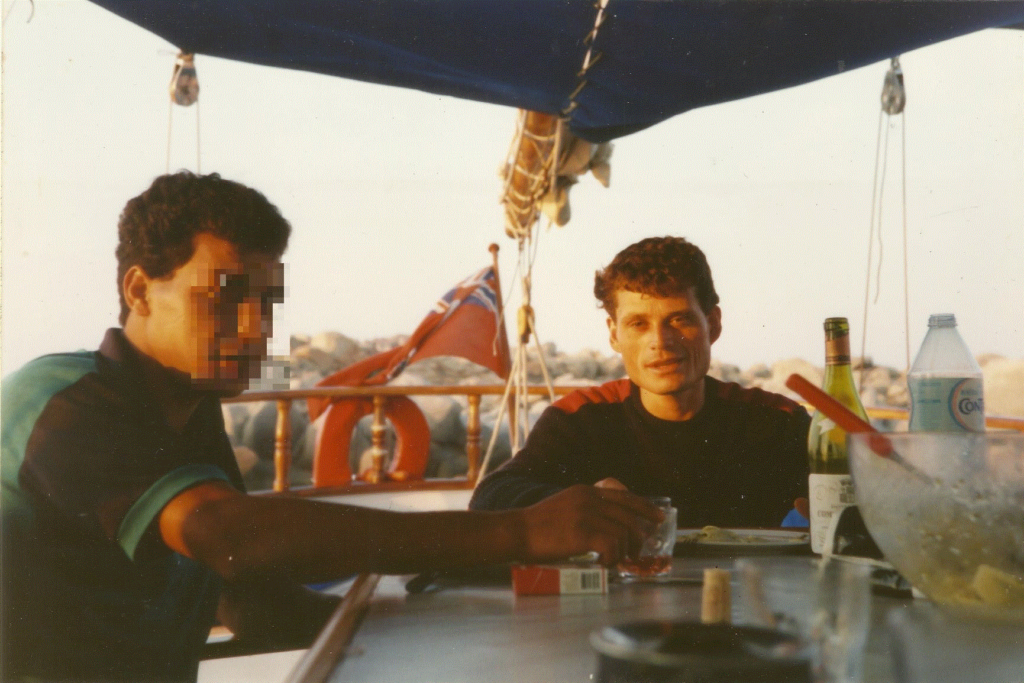
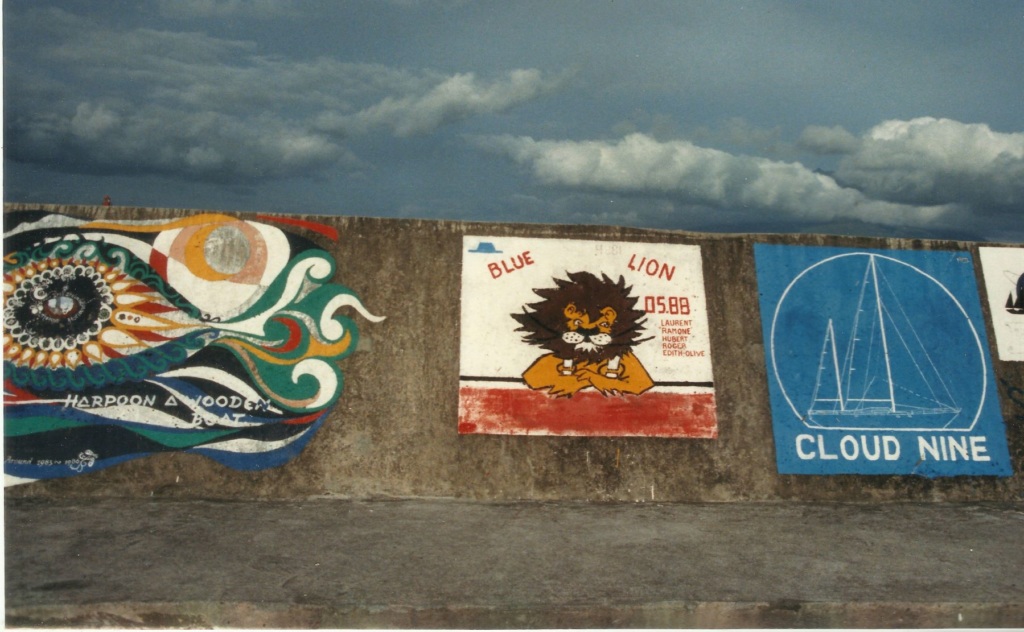

However, the magical owner one day stops sailing and puts his boat in the dock for a long time. Ulysses then decides to go to a mysterious continent which has always made sailors dream: Africa!
(Cover photo: The Blue Lion Schooner in the West Indies; possibly Dominic Island.)
Références

